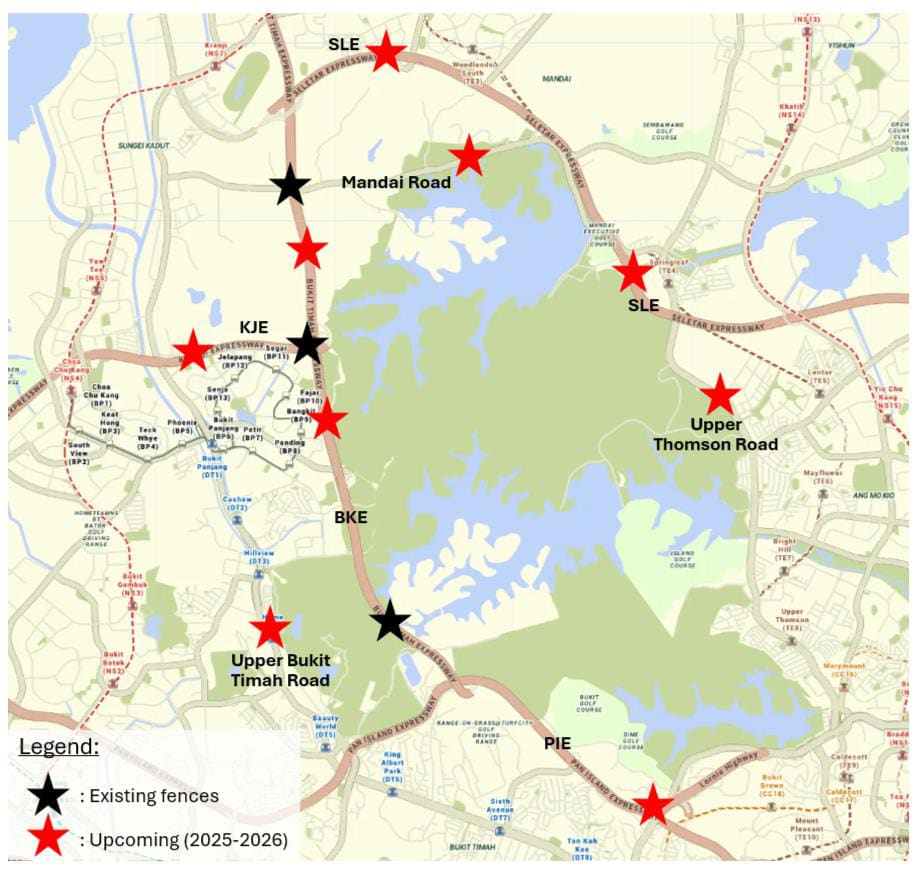Fencing along roads to be extended to 9 more areas to prevent vehicle-wildlife collisions
Areas where the barriers are already in place have seen cases of roadkill involving sambar deers and wild boars decline.

Fences and hedges such as these are meant to help prevent collisions between vehicles and wildlife. (File photos: NParks)

This audio is generated by an AI tool.
SINGAPORE: The National Parks Board (NParks) will set up barriers at nine new areas to help prevent collisions between vehicles and wildlife.
Exclusion fencing and hedge walls, which help deter animals from crossing roads, are already in place at three areas along Mandai Road and the Bukit Timah Expressway (BKE).
In a Facebook post on Monday (Apr 14), Minister for National Development Desmond Lee said that the results of the existing measures have been “encouraging”.
“We have seen a decrease in the number of sambar deer and wild boar roadkill incidents in Singapore from 2023 to 2024 in these areas.”
The fencing also helps guide the animals towards alternative crossings set up by NParks such as the Eco-Link@BKE.
“Vehicular-wildlife collisions not only pose serious risks to drivers, riders and passengers, they also harm our wildlife,” Mr Lee said.
“To do more to protect our motorists and wildlife, NParks will be extending exclusion fencing to nine additional locations over the next two years.”
The nine spots are higher-risk areas identified based on past incidents. They are mostly along major roads near the Bukit Timah Nature Reserve and Central Catchment Nature Reserve.
NParks said on Monday that it aims to finish setting up the fences by 2026.
The fences will be around 1.8m high to prevent large mammals from jumping over them.
Smooth panels will also be added to the bases of the fences to prevent animals such as pangolins from climbing over them onto the road.
“In Singapore where land is scarce, our green spaces are close to urban development areas,” Mr Lee said.
“That is why we have taken steps to introduce various measures to strengthen our ecological connectivity, making it safer for wildlife to move in between green spaces.”

MEASURES TAKEN OVER THE YEARS
Over the years, NParks has taken measures to facilitate the safe movement of Singapore’s wildlife and improve the safety of motorists.
These included road closures, wildlife crossing aids such as the Eco-Link@BKE, aerial rope bridges and culverts, an animal detection system and habitat enhancement.
Culverts are waste water pipes that cross under roads.
The government agency has also worked with various groups to track incidents of roadkill resulting from vehicular-wildlife collisions since 2014.
Some of the groups involved are the Animal Concerns Research and Education Society, the Herpetological Society of Singapore that studies reptiles and amphibians, the Mandai Wildlife Group as well as the non-profit Conservation International.
“Based on analysis of past records and in consultation with stakeholders, NParks has been progressively implementing exclusion fencing and hedge planting at hotspots for vehicular-wildlife collision,” the agency said.
It noted that at the spots where the fencing was put up, there were two roadkill cases involving sambar deers and wild boars last year, down from six in 2023.
A study by NParks also found that the presence of these barriers was linked to a higher chance of wildlife using alternative crossings instead of roads.
“NParks will continue to monitor the efficacy of these mitigation measures,” it said.
“The findings will guide the rollout at other locations and the measures will be adjusted and improved as necessary.”
It will also be working with other agencies to identify other mitigation measures that can be taken, it added.
NParks reminded motorists to be alert to animals crossing and drive within speed limits when travelling along roads flanked by forested areas, especially where there are signs to indicate such crossings.
Members of the public are reminded not to handle injured wild animals on their own. For urgent reports of wildlife requiring rescue, they may contact NParks’ 24-hour Animal Response Centre at 1800-476-1600.

















